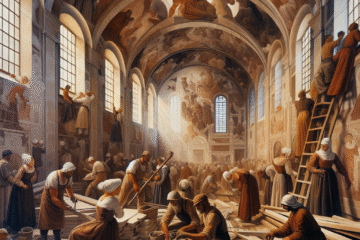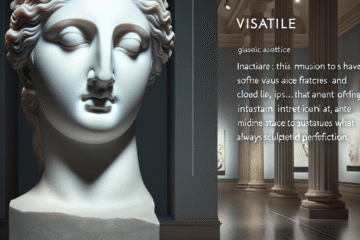I. Introduction
Modernism and avant-garde art are two interconnected movements that emerged in the late 19th and early 20th centuries as a reaction against the traditional norms and values of art. The two terms are often used interchangeably, although modernism refers to a broader cultural movement that includes literature, music, and architecture, while avant-garde art refers specifically to visual arts.
Modernism and avant-garde art are characterized by a radical departure from the past and a quest for new forms of expression. They challenged established conventions and sought to break down the boundaries between art and everyday life. The movements were marked by a spirit of experimentation, innovation, and a rejection of traditional forms and techniques.
Avant-garde art emerged in Europe in the late 19th century as a reaction against the academicism of the time. Artists were dissatisfied with the conservative attitudes of the art establishment and the lack of freedom to experiment with new forms and ideas. They sought to break free from the constraints of tradition and to create a new kind of art that was more expressive, more daring, and more in tune with the changing times.
Modernism emerged as a cultural movement in the early 20th century in response to the upheavals of the modern world. It was a period of rapid industrialization, urbanization, and technological advancement that challenged traditional ways of thinking and living. Modernist artists sought to capture the essence of this new world in their art, and they did so by exploring new forms, new materials, and new techniques.
The importance of modernism and avant-garde art in art history cannot be overstated. The movements were responsible for some of the most innovative and influential art of the 20th century. They opened up new possibilities for art, and they continue to inspire and influence artists today.
In the following sections, we will explore the roots, characteristics, key figures, controversies, and legacy of modernism and avant-garde art, and we will see how they have shaped the course of art history.
II. Roots of Modernism and Avant-Garde Art
Modernism and avant-garde art did not emerge out of nowhere. They were the result of a long process of social, cultural, and artistic changes that had been unfolding for centuries.
Pre-modernist art, which refers to the art that preceded modernism, was characterized by a focus on realism, naturalism, and the representation of the visible world. Art was largely a means of religious and political expression, and it was subject to strict rules and conventions. Artists were expected to adhere to these rules and to produce works that were faithful to the subject matter.
However, by the end of the 19th century, artists began to question the limitations of pre-modernist art. They felt that art should be more than just a reflection of reality, and that it should also express the emotions and ideas of the artist. They also felt that art should be more accessible to the general public, and that it should be more relevant to the changing times.
Social and cultural changes were also major factors that led to the emergence of modernism and avant-garde art. The late 19th century saw a wave of industrialization and urbanization that transformed society and culture. Cities grew larger, and new technologies and machines made life faster and more efficient. The traditional values and beliefs of the past were challenged by new scientific discoveries, philosophical ideas, and political movements.
Artists responded to these changes by seeking new forms of expression that reflected the complexity and diversity of the modern world. They experimented with new techniques and materials, and they challenged traditional subject matter and themes. They sought to break down the boundaries between art and everyday life, and to create works that were more relevant, more accessible, and more democratic.
The rise of photography and cinema also had a profound impact on modernism and avant-garde art. Artists were inspired by the new visual language of these media, and they incorporated elements of them into their own works. They explored the possibilities of abstraction, minimalism, and non-representational art, and they experimented with new forms of installation, performance, and conceptual art.
In conclusion, the roots of modernism and avant-garde art can be traced back to the limitations of pre-modernist art and the social and cultural changes of the late 19th century. These movements were a response to the challenges of the modern world, and they sought to create new forms of expression that reflected the complexity and diversity of the times.
III. Characteristics of Modernism and Avant-Garde Art
Modernism and avant-garde art are characterized by a number of distinct features that set them apart from pre-modernist art. These features include experimentation with form, technique, and materials, abstraction and minimalism, rejection of traditional subject matter and themes, and an emphasis on individualism and self-expression.
Experimentation with form, technique, and materials
One of the hallmarks of modernism and avant-garde art is a willingness to experiment with new forms, techniques, and materials. Artists sought to break free from the constraints of tradition and to explore new possibilities in art. They pushed the boundaries of what was considered acceptable in art, and they were constantly pushing the envelope in terms of what could be achieved with their chosen medium.
Abstraction and minimalism
Another key feature of modernism and avant-garde art is the emphasis on abstraction and minimalism. Artists sought to strip away unnecessary details and to focus on the essential elements of their subject matter. They sought to create works that were more about the form and the structure of the work, rather than the subject matter itself. This resulted in works that were often very simple and spare, yet very powerful and evocative.
Rejection of traditional subject matter and themes
Modernism and avant-garde art also rejected traditional subject matter and themes. Artists sought to break free from the constraints of the past and to explore new subjects and ideas. They rejected the religious and political themes that had dominated pre-modernist art, and they focused instead on everyday life and the experiences of the individual.
Emphasis on individualism and self-expression
Finally, modernism and avant-garde art placed a great emphasis on individualism and self-expression. Artists sought to express their own unique perspectives and experiences through their work, and they rejected the idea that art should be made for any particular purpose other than the expression of the artist’s own ideas and feelings. This led to a great diversity of styles and approaches within modernism and avant-garde art, as each artist sought to find their own voice and their own way of expressing themselves.
In conclusion, the characteristics of modernism and avant-garde art include a willingness to experiment with form, technique, and materials, an emphasis on abstraction and minimalism, a rejection of traditional subject matter and themes, and an emphasis on individualism and self-expression. These characteristics set modernism and avant-garde art apart from pre-modernist art and continue to influence artists today.
IV. Key Figures and Movements in Modernism and Avant-Garde Art
Modernism and avant-garde art were characterized by a rich diversity of styles and approaches, each with their own unique contribution to the movements. In this section, we will explore four key movements and figures that played a major role in the development of modernism and avant-garde art: Fauvism, Cubism, Dadaism, and Surrealism.
Fauvism and the use of vibrant, bold colors
Fauvism emerged in France in the early 20th century, and it is characterized by its use of vibrant, bold colors and its rejection of naturalistic representation. Fauvist painters sought to capture the emotional impact of color and to express their own individual responses to the world around them. Key figures of Fauvism include Henri Matisse, André Derain, and Raoul Dufy.
Cubism and the fragmentation of form
Cubism is one of the most influential movements in the history of modern art. It emerged in France in the early 20th century and is characterized by its fragmentation of form and its rejection of traditional perspective. Cubist painters sought to break down objects into their component parts and to depict them from multiple viewpoints. Key figures of Cubism include Pablo Picasso and Georges Braque.
Dadaism and the rejection of reason and logic
Dadaism emerged in Europe during World War I, and it is characterized by its rejection of reason and logic. Dadaist artists sought to challenge traditional artistic values and to create works that were absurd, nonsensical, and often deliberately offensive. Key figures of Dadaism include Marcel Duchamp, Tristan Tzara, and Hans Arp.
Surrealism and the exploration of the unconscious mind
Surrealism emerged in France in the 1920s, and it is characterized by its exploration of the unconscious mind and its use of dreamlike imagery. Surrealist artists sought to create works that were both irrational and highly symbolic, and they often incorporated elements of chance and spontaneity into their work. Key figures of Surrealism include Salvador Dalí, Max Ernst, and René Magritte.
In conclusion, Fauvism, Cubism, Dadaism, and Surrealism are just a few of the key movements and figures that played a major role in the development of modernism and avant-garde art. Each of these movements and figures made a significant contribution to the artistic and cultural landscape of the 20th century, and their influence continues to be felt in the world of art today.
V. Criticisms and Controversies Surrounding Modernism and Avant-Garde Art
Modernism and avant-garde art were not without their critics and controversies. In this section, we will explore some of the criticisms and controversies that have surrounded these movements throughout their history.
Reactions from the art establishment and the general public
One of the primary criticisms of modernism and avant-garde art has been the negative reaction from the art establishment and the general public. Many art critics and museum curators were dismissive of these movements, viewing them as a threat to traditional artistic values and practices. Some critics accused modernist and avant-garde artists of being pretentious and self-indulgent, and they argued that their works lacked skill and craftsmanship.
The general public was often similarly skeptical of modernist and avant-garde art. Many people found these works to be confusing, strange, or even offensive. Some accused modernist and avant-garde artists of deliberately creating works that were inaccessible to the general public as a way of asserting their superiority.
Accusations of elitism and lack of accessibility
Another criticism of modernism and avant-garde art is that they are elitist and lack accessibility. Many of the works produced by these movements were highly abstract or conceptual, and they often required a great deal of specialized knowledge or background to appreciate. Some critics argued that this made modernist and avant-garde art inaccessible to all but a select few, and that it was therefore of limited value to society as a whole.
The commercialization of modern art
Finally, modernism and avant-garde art have been criticized for their commercialization. As these movements gained popularity, many artists began to see their works as products to be bought and sold on the open market. Some critics argued that this led to a focus on producing works that were highly marketable, rather than works that were true to the artist’s vision or to the ideals of the movements.
In conclusion, modernism and avant-garde art have been the subject of numerous criticisms and controversies throughout their history. These movements have been accused of being pretentious, self-indulgent, elitist, and lacking in accessibility. They have also been criticized for their commercialization, and for the focus on producing works that are highly marketable rather than true to the artist’s vision. Despite these criticisms, modernism and avant-garde art continue to be highly influential and important movements in the history of art.
VI. Legacy of Modernism and Avant-Garde Art
Modernism and avant-garde art had a profound impact on the course of art history, and their influence can still be felt in the world of art and culture today. In this section, we will explore the legacy of modernism and avant-garde art, including their influence on subsequent art movements and styles, their enduring impact on contemporary art and culture, and the continuing relevance of the movement’s values and ideals.
Influence on subsequent art movements and styles
One of the most significant legacies of modernism and avant-garde art is their influence on subsequent art movements and styles. Many of the techniques and ideas that were developed by modernist and avant-garde artists have been adopted and adapted by later generations of artists. For example, the use of abstraction and minimalism in modernist and avant-garde art has influenced subsequent movements such as Abstract Expressionism and Minimalism. Similarly, the exploration of the unconscious mind in Surrealism has influenced later movements such as Pop Art and Neo-Expressionism.
The enduring impact on contemporary art and culture
Another important legacy of modernism and avant-garde art is their enduring impact on contemporary art and culture. Many of the techniques and ideas that were developed by these movements continue to be relevant and influential today. For example, the emphasis on individualism and self-expression that was central to modernism and avant-garde art has become a cornerstone of contemporary art and culture. Similarly, the use of new technologies and materials that was pioneered by modernist and avant-garde artists continues to be a major focus of contemporary art.
The continuing relevance of the movement’s values and ideals
Finally, the values and ideals that were central to modernism and avant-garde art continue to be relevant and important today. These movements placed a great emphasis on experimentation, innovation, and a rejection of tradition, and these values continue to be important for artists and cultural producers today. Modernism and avant-garde art also emphasized the importance of individualism and self-expression, and these values continue to be essential for artists who seek to create work that is authentic and meaningful.
In conclusion, the legacy of modernism and avant-garde art is vast and far-reaching. These movements continue to influence contemporary art and culture, and their ideas and techniques continue to be relevant and important for artists today. The enduring impact of these movements is a testament to their importance and significance in the history of art, and to the enduring power of creativity and innovation in human culture.
VII. Conclusion
Modernism and avant-garde art were two of the most influential movements in the history of art, and their impact can still be felt today. In this article, we have explored the definition and importance of these movements, their roots in pre-modernist art and social and cultural changes, their key characteristics, key figures and movements, criticisms and controversies, and their legacy.
A recap of the key points covered in this article includes:
- Modernism and avant-garde art were characterized by experimentation, abstraction, rejection of traditional subject matter and themes, and an emphasis on individualism and self-expression.
- Fauvism, Cubism, Dadaism, and Surrealism were key movements that played a major role in the development of modernism and avant-garde art.
- These movements were criticized for being pretentious, self-indulgent, elitist, and lacking in accessibility, as well as for their commercialization.
- However, the enduring impact of modernism and avant-garde art is vast and far-reaching. These movements continue to influence contemporary art and culture, and their ideas and techniques continue to be relevant and important for artists today.
In conclusion, the ongoing significance of modernism and avant-garde art in art history and society cannot be overstated. These movements paved the way for new forms of artistic expression, challenged traditional values and beliefs, and expanded the boundaries of what was considered acceptable in art. Today, artists continue to draw inspiration from the techniques, ideas, and values of modernism and avant-garde art, and their legacy continues to shape the world of art and culture.


